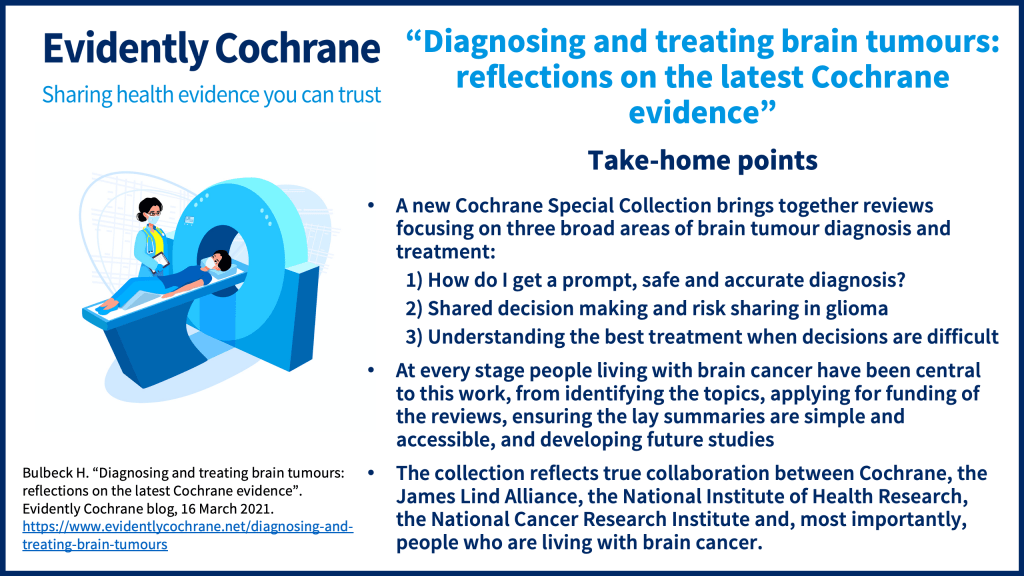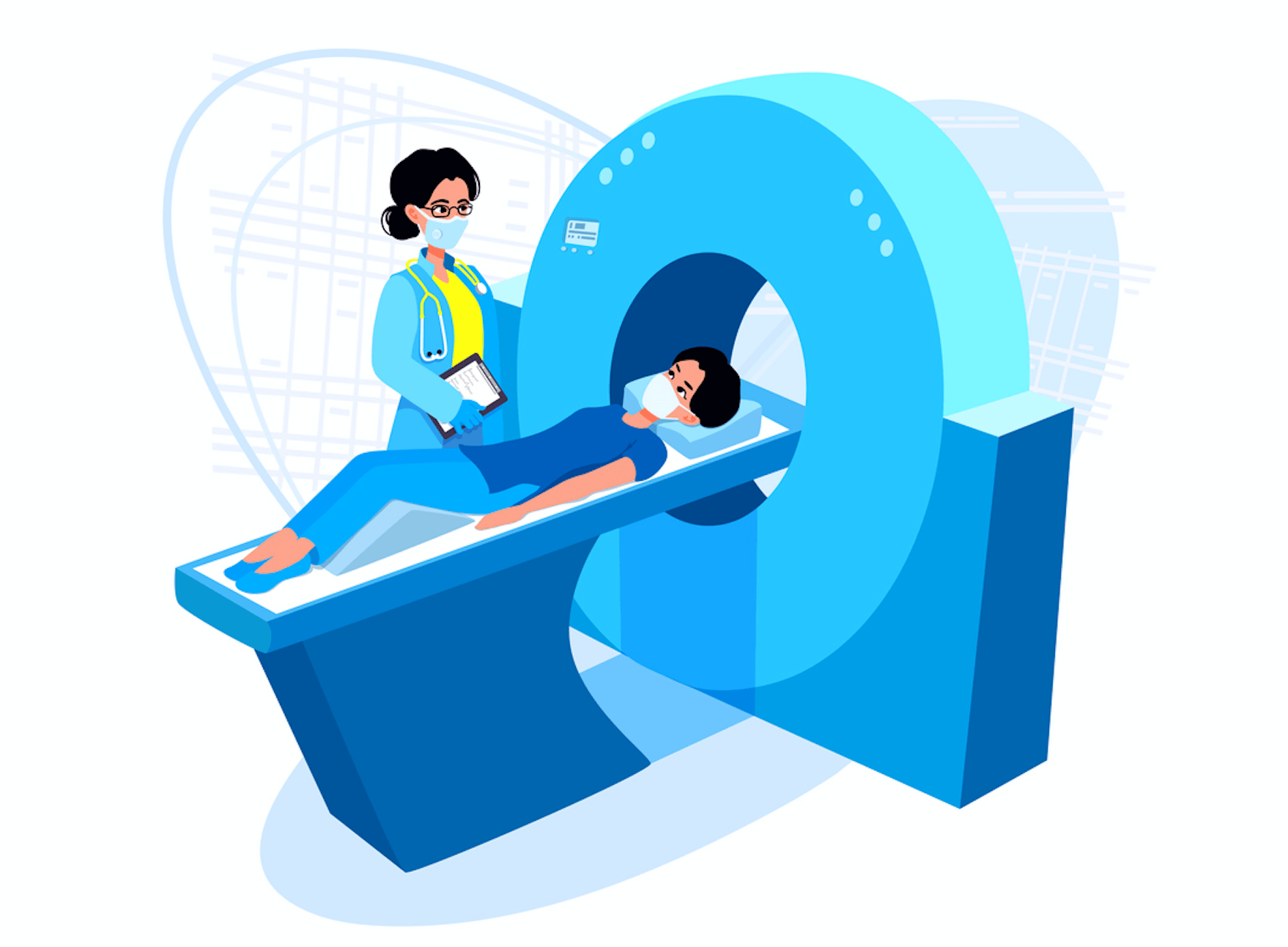In this blog for people living with a brain tumour, healthcare practitioners and anyone with an interest in brain tumours, Helen Bulbeck, Cochrane consumer‘Consumer’ is Cochrane’s preferred term for patients (or someone with personal experience of a health condition), care-givers or family members of someone with a health condition. (https://consumers.cochrane.org) representative and director of policy and services for brainstrust, looks at the latest Cochrane evidenceCochrane Reviews are systematic reviews. In systematic reviews we search for and summarize studies that answer a specific research question (e.g. is paracetamol effective and safe for treating back pain?). The studies are identified, assessed, and summarized by using a systematic and predefined approach. They inform recommendations for healthcare and research. on brain tumours and reflects on what this special collection means for the brain tumour community and why collaboration has been key to the success of this work.
Page last checked 30 June 2023

What matters to patients with brain tumours
When you are diagnosed with a brain tumour, you cycle through emotions of fear, anxiety, sadness, anger. The reaction is unguarded and visceral. Inevitably the values and beliefs that have made us who we are come into question – our sense of identity and purpose, and our relationship to those around us.
Take Andrew. Andrew is 42 years old, recently divorced, has three teenage children. He is living in rented accommodation which is unsuitable as a home for his children. He has been diagnosed with a glioblastoma, the most aggressive of brain tumours. With treatmentSomething done with the aim of improving health or relieving suffering. For example, medicines, surgery, psychological and physical therapies, diet and exercise changes. he has a prognosis of about 9 to 15 months. He has lost his driving licence because of his diagnosis, and with this, his job as a carpenter. He is angry and isolated, feels guilty and fearful about what lies ahead. And yet every conversation he has with his clinical team is focused on treatment and his symptoms; he doesn’t know how to begin to talk about what really matters to him.
This is why our work to publish a collection of reviews addressing questions that matter to patients about the diagnosis and treatment of brain tumours is so important. The identification of important topics for clinical research and how to fund it is paramount if we are to improve the outcome for people like Andrew. Historically, the topics chosen for research, grant submissions and the selection of grants for funding have been driven by academia, rather than the people who are living with brain cancer.
Many steps in the topic identification process are open to conflicts of interest or biasAny factor, recognised or not, that distorts the findings of a study. For example, reporting bias is a type of bias that occurs when researchers, or others (e.g. drug companies) choose not report or publish the results of a study, or do not provide full information about a study., and where success is driven by attracting grants there are always concerns around the independence of those who sit on grant giving bodies. This is even more relevant when the research is focused on a rare, or less common disease, such as brain cancer, where it is hard to work with large cohorts. Over-hyped basic scientific submissions, over-promised disease cures, commercial links with biotech/pharma and increased pressure on those identifying topics for funding means that we need to be transparent in the research selection processes. This ensures there is no conflict of interest or bias towards cell-based research, which can detract from the clinically relevant research that the brain cancer community needs.
Putting patients at the heart of the Cochrane Evidence on brain tumours
In 2015, the Neuro-oncology James Lind Alliance Priority Setting Partnership (JLA PSP) published its top ten priorities, identified by brain and spinal cord tumour patients, carers, major brain and spinal cord tumour charities and multidisciplinary professional organisations.
In December 2017, the Cochrane Gynaecology Neuro-Oncology and Orphan Cancer Group (CGNOC), in collaboration with the National Cancer Research Institution (NCRI) Brain Group, was successful in being awarded a systematic review programme grant to complete 8 complex reviews. The reviews focus on many of the priority topics identified and are categorised into three broad research areas:
- How do I get a prompt, safe and accurate diagnosis?
- Shared decision making and riskA way of expressing the chance of an event taking place, expressed as the number of events divided by the total number of observations or people. It can be stated as ‘the chance of falling were one in four’ (1/4 = 25%). This measure is good no matter the incidence of events i.e. common or infrequent. sharing in glioma
- Understanding the best treatment when decisions are difficult.
These reviews have been brought together in a new Cochrane Special Collection: Brain tumour diagnosis and management.
A resource for now, as well as improving future research
These systematic reviewsIn systematic reviews we search for and summarize studies that answer a specific research question (e.g. is paracetamol effective and safe for treating back pain?). The studies are identified, assessed, and summarized by using a systematic and predefined approach. They inform recommendations for healthcare and research. have already supported many recently funded, NCRI adopted studies. More importantly though they create touchpoints for people who are living with brain cancer. We know that having a prompt diagnosis is a concern; people feel if there had been an earlier diagnosis, then outcomesOutcomes are measures of health (for example quality of life, pain, blood sugar levels) that can be used to assess the effectiveness and safety of a treatment or other intervention (for example a drug, surgery, or exercise). In research, the outcomes considered most important are ‘primary outcomes’ and those considered less important are ‘secondary outcomes’. may have been different for the people they love. However, diagnosing a brain tumour is complex and there are benefits and harms of early detection and treatment.
The day my dad was diagnosed with a brain tumour he stopped his gym membership. I was almost sadder about the way he stopped all the things that meant something to him, that gave him purpose. Would an earlier diagnosis have made a difference? It wouldn’t have changed the outcome. It would though have meant he was living longer with the knowledge that he was going to die and would have given up his quality of life much sooner. Caregiver
Supporting shared decision-making
We know too that shared decision making and weighing up pros and cons of whether to treat, or not to treat, helps people to reframe problems, generate insights, shift dynamics, and change practice. If we ignore the patient voice, we have a disconnect between the medical approach to disease (clinicians’ focus) and what patients care about. Our experience is that researchers and clinicians sometimes focus on overall survival and progression-free survival; patients focus on quality of life, function, and symptom relief. Using shared decision-making allows everyone to become copilots in their care, so that we see a new model of maintenance of wellness as well as treatment of illness.
There comes a point in the brain tumour pathway where a malignant brain tumour will come back. This may mean that new decisions need to be made at a time when emotions are high, and hope needs to be nurtured when the future looks bleak. At the moment there is no clear protocolThe plan or set of steps to be followed in a study. A protocol for a systematic review should describe the rationale for the review, the objectives, and the methods that will be used to locate, select, and critically appraise studies, and to collect and analyse data from the included studies. The protocols for Cochrane Reviews are available in the Cochrane Library. for what to do when first line treatment fails so having the evidence review for recurrence ‘Treatment options for recurrent glioblastoma: a network meta-analysis’ gives potential for a transformative conversation about options going forward.
Changing outcomes for those that matter: the ongoing journey
Five years on we can look back at what has been achieved, and to look forward to what’s next. These priorities are more than just interesting; embraced and embedded in the DNA of neuro-oncology clinical research, they are changing outcomes for those that matter – for people like Andrew, who are living with a brain tumour. Identifying the top ten priorities was just the start of a journey – the easy part. Making this effort relevant and meaningful for the brain tumour community was always in our line of sight and we knew it would need collaboration if the outcomes were to be an influential driver for change.
At every stage people living with brain cancer have been in the DNA of this work, from identifying the topics, applying for funding of the reviews, ensuring the lay summaries are simple and accessible, developing future studies through the NCRI. We’d like to acknowledge this effort – this success story, the transformation of the neuro-oncology clinical research landscape – wouldn’t have happened without patients, their caregivers, and the clinicians who support the community.
Thank you.
Join in the conversation on Twitter with @bulbeckhelen @CochraneUK and @Cochrane_GNOCG or leave a comment on the blog. Comments are checked by the Editors before they are made public on the blog.
Please note, we cannot give specific medical advice and do not publish comments that link to individual pages requesting donations or to commercial sites, or appear to endorse commercial products. We welcome diverse views and encourage discussion but we ask that comments are respectful and reserve the right to not publish any we consider offensive. Cochrane UK does not fact check – or endorse – readers’ comments, including any treatments mentioned.
People who comment on our blogs often have further questions, including about the effects of treatments. If you have a question about a health claim you have heard or read (e.g. does the use of petrol pumps spread COVID-19 (coronavirus disease)?) you can submit it to iHealthFacts, a fact-checking resource.
References
James Lind Alliance Priority Setting Partnerships. Neuro-oncology Top 10. James Lind Alliance, 2015. Web. 16 March 2021. Available from https://www.jla.nihr.ac.uk/priority-setting-partnerships/neuro-oncology/top-10-priorities/
Grant R, Bulbeck H, Quinn G, Harrison T, Tomlinson E, Monaz M. Brain tumour diagnosis and management. Cochrane Library, Cochrane Special Collections, 17 March 2021. Web. 17 March 2021. Available from: https://www.cochranelibrary.com/collections/doi/SC000050/full
McBain C, Lawrie TA, Rogozińska E, Kernohan A, Robinson T, Jefferies S. Treatment options for progression or recurrence of glioblastoma: a network meta‐analysis. Cochrane Database of Systematic Reviews 2021, Issue 1. Art. No.: CD013579. DOI: 10.1002/14651858.CD013579.pub2. https://www.cochranelibrary.com/cdsr/doi/10.1002/14651858.CD013579.pub2/full
Disclosure of interest: Helen Bulbeck has nothing to disclose.



1. commonsense and understanding. 2.NICE guidelines are now poor.3.Neurooncology nurses need training and time to attend courses which is paid for. 4 When the diagnosis arrives ,health comes first but within an hour, work ,money, accommodation etc hit all the family-in hospital medical social worker is required to coordinate with specialist nurse/doctor support, immediately.-help fill in al the forms and apply for benefits and deal with employers-handbook required. It is noteworthy, with the exception of one medical school, that doctors dont know what tax credit etc means. 5, psychology support is thin on the ground.